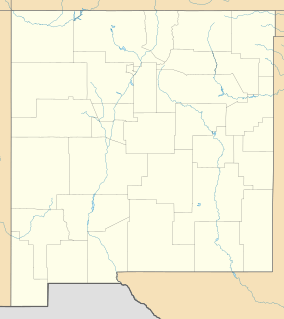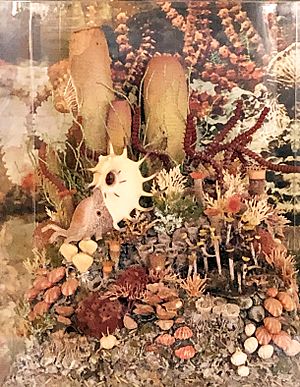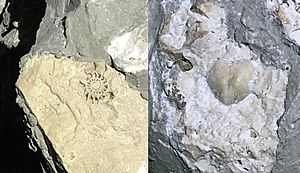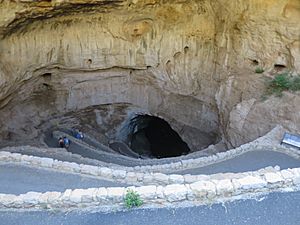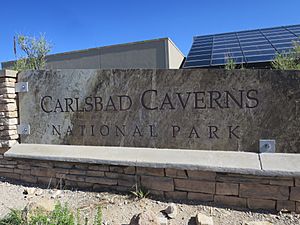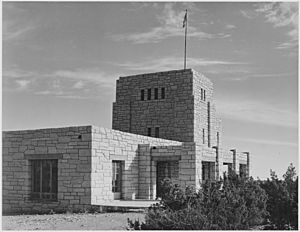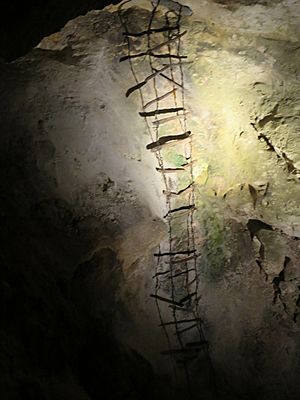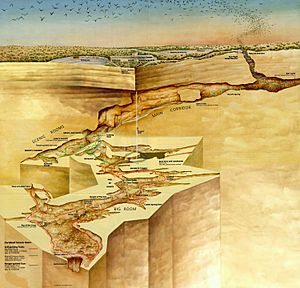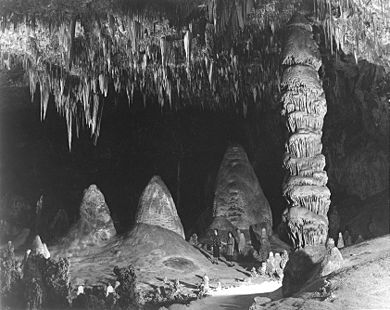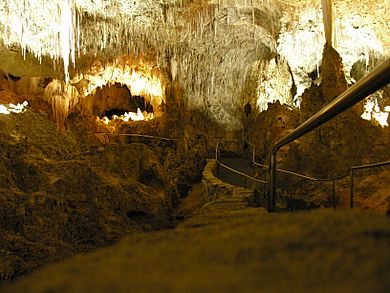Carlsbad Caverns National Park facts for kids
Quick facts for kids Carlsbad Caverns National Park |
|
|---|---|
|
IUCN Category II (National Park)
|
|
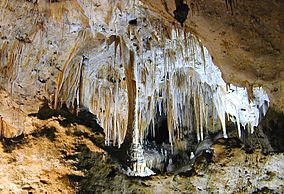
The cave is well-known for its many calcite formations such as this column and array of stalactites.
|
|
| Location | Eddy County, New Mexico, US |
| Nearest city | Carlsbad, New Mexico |
| Area | 46,766 acres (18,926 ha) 339 acres (137 ha) private |
| Established | May 14, 1930 |
| Visitors | 440,691 (in 2019) |
| Governing body | National Park Service |
| Type: | Natural |
| Criteria: | vii, viii |
| Designated: | 1995 (19th session) |
| Reference #: | 721 |
| Region: | North America |
Carlsbad Caverns National Park is a super cool national park in the Guadalupe Mountains of southeastern New Mexico. The main reason people visit is to explore the amazing Carlsbad Cavern. You can walk into the cave through its natural entrance or take a quick elevator ride from the visitor center.
The park is located about 18 miles southwest of Carlsbad, New Mexico. It's a special place, with about two-thirds of it protected as a wilderness area. This means the natural habitat will stay untouched for a long time.
Carlsbad Cavern has a huge limestone room called the Big Room. It's almost 4,000 feet long, 625 feet wide, and 255 feet high! This makes it the largest cave chamber in North America and the 32nd largest in the whole world.
Carlsbad Caverns became a national park in 1930. Later, in 1995, it was named a World Heritage Site. People all over the world know it as one of the best and easiest-to-visit cave systems.
Contents
How the Caves Were Formed: Geology Basics
Ancient Seas and Reefs
Imagine this area 250 million years ago! It was the coastline of an inland sea. This sea was full of tiny marine creatures. Their remains slowly built up to form a huge reef. This ancient reef was different from today's coral reefs. It was made of things like bryozoans (tiny water animals) and sponges.
After a long time, the sea dried up. The reef got buried under layers of salt and other sediments. Then, huge movements of the Earth's crust, called tectonic movement, pushed the reef upwards. This created the Guadalupe Mountains. Over millions of years, water and wind slowly shaped these mountains into what we see today.
How the Caverns Were Carved
Carlsbad Caverns formed in limestone rock. Deep below the limestone, there are reserves of petroleum (oil). Over time, a gas called hydrogen sulfide (H2S) seeped up from the oil into the groundwater.
When hydrogen sulfide mixed with oxygen in the water, it created sulfuric acid. This acid is very strong! It aggressively dissolved the limestone, carving out the huge caverns we see today. You can find gypsum in the cave, which is a leftover mineral from this acid-rock reaction.
Amazing Cave Formations
Once the acidic water drained away, the caves became dry. Then, beautiful cave formations, called speleothems, started to grow. These are made from minerals left behind by dripping water.
Rainwater and melting snow soak into the ground. They pick up carbon dioxide, making the water slightly acidic. When this water drips into the cave, it leaves behind tiny bits of calcium carbonate. These bits slowly build up.
- Stalactites: These grow downwards from the cave ceiling, like icicles.
- Stalagmites: These grow upwards from the cave floor, like mounds.
Other cool formations include columns (when stalactites and stalagmites meet), soda straws (thin, hollow tubes), draperies (wavy sheets of rock), helictites (twisty, gravity-defying growths), and cave popcorn (bumpy clusters). The colors of these formations come from tiny minerals in the rock.
Weather at the Park
The area around Carlsbad Caverns has a cool, dry climate. This means it gets some rain, but not a lot, and temperatures can vary.
| Climate data for Carlsbad Caverns, New Mexico, 1991–2020 normals, extremes 1935–present | |||||||||||||
|---|---|---|---|---|---|---|---|---|---|---|---|---|---|
| Month | Jan | Feb | Mar | Apr | May | Jun | Jul | Aug | Sep | Oct | Nov | Dec | Year |
| Record high °F (°C) | 81 (27) |
86 (30) |
90 (32) |
96 (36) |
106 (41) |
110 (43) |
106 (41) |
105 (41) |
100 (38) |
97 (36) |
87 (31) |
82 (28) |
110 (43) |
| Mean maximum °F (°C) | 72.8 (22.7) |
76.6 (24.8) |
83.3 (28.5) |
88.8 (31.6) |
96.7 (35.9) |
102.3 (39.1) |
100.8 (38.2) |
98.2 (36.8) |
93.8 (34.3) |
88.8 (31.6) |
79.9 (26.6) |
72.9 (22.7) |
104.1 (40.1) |
| Mean daily maximum °F (°C) | 56.0 (13.3) |
60.9 (16.1) |
67.9 (19.9) |
75.7 (24.3) |
84.1 (28.9) |
92.4 (33.6) |
91.2 (32.9) |
90.3 (32.4) |
83.2 (28.4) |
75.4 (24.1) |
64.6 (18.1) |
56.6 (13.7) |
74.9 (23.8) |
| Daily mean °F (°C) | 44.9 (7.2) |
48.8 (9.3) |
55.2 (12.9) |
62.5 (16.9) |
71.2 (21.8) |
79.1 (26.2) |
79.5 (26.4) |
78.3 (25.7) |
71.8 (22.1) |
63.8 (17.7) |
53.2 (11.8) |
45.9 (7.7) |
62.8 (17.1) |
| Mean daily minimum °F (°C) | 33.7 (0.9) |
36.8 (2.7) |
42.6 (5.9) |
49.3 (9.6) |
58.3 (14.6) |
65.7 (18.7) |
67.8 (19.9) |
66.3 (19.1) |
60.4 (15.8) |
52.1 (11.2) |
41.9 (5.5) |
35.1 (1.7) |
50.8 (10.4) |
| Mean minimum °F (°C) | 17.7 (−7.9) |
20.7 (−6.3) |
26.2 (−3.2) |
33.6 (0.9) |
43.8 (6.6) |
56.9 (13.8) |
60.3 (15.7) |
59.8 (15.4) |
49.7 (9.8) |
34.8 (1.6) |
25.5 (−3.6) |
19.6 (−6.9) |
13.7 (−10.2) |
| Record low °F (°C) | −4 (−20) |
−4 (−20) |
10 (−12) |
21 (−6) |
31 (−1) |
41 (5) |
42 (6) |
47 (8) |
33 (1) |
15 (−9) |
8 (−13) |
2 (−17) |
−4 (−20) |
| Average precipitation inches (mm) | 0.32 (8.1) |
0.44 (11) |
0.57 (14) |
0.50 (13) |
1.25 (32) |
1.16 (29) |
2.23 (57) |
2.00 (51) |
2.93 (74) |
1.16 (29) |
0.68 (17) |
0.55 (14) |
13.79 (350) |
| Average snowfall inches (cm) | 0.4 (1.0) |
0.9 (2.3) |
0.0 (0.0) |
0.0 (0.0) |
0.0 (0.0) |
0.0 (0.0) |
0.0 (0.0) |
0.0 (0.0) |
0.0 (0.0) |
0.0 (0.0) |
0.2 (0.51) |
2.0 (5.1) |
3.5 (8.9) |
| Average precipitation days (≥ 0.01 in) | 3.7 | 2.7 | 3.2 | 2.3 | 3.5 | 4.8 | 5.6 | 6.4 | 6.2 | 5.1 | 3.0 | 3.2 | 49.7 |
| Average snowy days (≥ 0.1 in) | 0.5 | 0.5 | 0.0 | 0.0 | 0.0 | 0.0 | 0.0 | 0.0 | 0.0 | 0.0 | 0.2 | 0.6 | 1.8 |
| Source 1: NOAA | |||||||||||||
| Source 2: National Weather Service | |||||||||||||
History of Discovery and Access
In 1898, a brave teenager named Jim White explored the cavern. He used a ladder he made himself! Jim named many of the famous rooms, like the Big Room and King's Palace. He also named formations such as the Totem Pole and Rock of Ages.
The nearby town of Carlsbad, which gives the park its name, is named after a town in the Czech Republic. That town was once called Karlsbad, meaning "Charles' Baths."
For many years, visitors had to walk 750 feet down into the cave. The walk back up was very tiring! In 1932, the park opened a new visitor center. It had two elevators that could take people easily into and out of the caverns. This new center also included a cafeteria and a museum.
Becoming a National Park
- 1923: President Calvin Coolidge declared the area Carlsbad Cave National Monument. This protected the amazing cave.
- 1930: The United States Congress officially made it Carlsbad Caverns National Park. This meant it would be managed by the National Park Service.
- 1978: A large part of the park became the Carlsbad Caverns Wilderness. This ensures that the natural environment remains untouched.
Exploring the Named Rooms
Some of these rooms are not open to the public for safety reasons.
- Balloon Ballroom
- This small room is high up in the ceiling. Explorers first reached it by floating balloons with a rope attached!
- Bat Cave
- A large, rocky passage where most of the cave's bats live. In the past, bat guano (poop) was mined from here.
- Bell Cord Room
- Named for a long, thin stalactite that looks like a bell rope. It's at the end of the Left Hand Tunnel.
- Bifrost Room
- Discovered in 1982, this room is above the Lake of the Clouds. Its name comes from a Norse myth about a rainbow bridge to the sky. The room has colorful formations.
- Big Room or The Hall of the Giants
- This is the largest chamber in Carlsbad Caverns. It's huge, covering an area of 357,469 square feet!
- Chocolate High
- A maze of small passages, almost a mile long. It was found in 1993 above a muddy pit.
- Green Lake Room
- Named for a deep, green pool of water. It's one of the "Scenic Rooms."
- Guadalupe Room
- Discovered in 1966, this is the second largest room. It's famous for its many "soda straw" stalactites.
- Hall of the White Giant
- A large room with a giant, white stalagmite. Special tours go here.
- Halloween Hall
- A room about 30 feet long, found on October 31, 2013. It's located above the Spirit World.
- King's Palace
- The first of four "scenic rooms." It's named for a large, castle-like formation.
- Lake of the Clouds
- This is the lowest known point in the cave. It has a lake with cloud-like rock formations that formed underwater.
- Left Hand Tunnel
- A long, straight passage with deep cracks in the floor. It leads to the Lake of the Clouds.
- Lil' Lechuguilla
- Discovered in 2019, this room has delicate gypsum formations, similar to those in Lechuguilla Cave.
- Mabel's Room
- A medium-sized room in the Lower Cave.
- Mystery Room
- A large, sloped room where a strange heartbeat-like noise is sometimes heard.
- New Mexico Room
- Located next to the Green Lake Room.
- Papoose Room
- Found between the King's Palace and Queen's Chamber.
- Queen's Chamber
- Many people think this is the most beautiful part of the cave.
- Spirit World
- High up in the Big Room, this area has white stalagmites that looked like angels to the explorers who found them.
- Talcum Passage
- In Lower Cave, the floor here is covered in fine gypsum dust, like talcum powder.
- The Rookery
- One of the larger rooms in Lower Cave, known for its many cave pearls.
- Underground Lunchroom
- Located in the Big Room, this cafeteria was built in the 1950s. It's where the elevators bring visitors into the cave.
Visiting Carlsbad Caverns
Carlsbad Caverns gets about 410,000 visitors each year. The busiest times are usually around Memorial Day and the Fourth of July weekends. Sometimes, you can visit for free on holidays like Martin Luther King, Jr. weekend. If you want to camp in the park's wilderness, you'll need a permit from the visitor center.
Bat Flight Viewing
One of the most popular events is watching the bats fly out of the cave! Every evening, from Memorial Day weekend to mid-October, a park ranger gives a talk. Then, visitors watch thousands of Mexican free-tailed bats spiral out of the natural entrance. This usually starts around sunset and can last for about three hours. The best time to see them is in July and August when the baby bats join the adults. You can also watch them return to the cave at dawn.
Star Parties
Throughout the year, the park hosts "star parties" at night. Rangers share information about the night sky, and telescopes are available for visitors to use. These events are often held during special astronomical events, like when planets align.
Recent Discoveries in the Cave
Explorers are still finding new parts of Carlsbad Cavern!
In 1985, a clever new way to explore was invented. Explorers used helium balloons to float a lightweight cord over a tall stalagmite. This allowed them to pull a climbing rope into place and reach a new area they called The Spirit World. A smaller room, the Balloon Ballroom, was found using this same method.
In 1993, explorers found a series of small passages in the ceiling of the New Mexico Room. These passages, almost a mile long, were named "Chocolate High." It was the biggest discovery in the cave since 1966!
The "Bottomless Pit" was once thought to have no bottom. People would throw stones into it and hear no sound. Later, explorers found it was about 140 feet deep. The bottom was covered in soft dirt, which muffled the sound of the stones.
On Halloween in 2013, a cave technician found a new chamber high above the Spirit World. It was named "Halloween Hall." This room is about 100 feet wide, and over 1,000 bat bones were found inside!
In 2018, a team squeezed through a tiny passage in the Mystery Room. They discovered new areas of the cavern, giving them names like the Tomb of the Sky Bears. They also mapped the second-deepest part of the cave, called Lake of Muddy Misery. Thanks to volunteers, the total mapped length of Carlsbad Cavern is now almost 40 miles!
Other Caves in the Park
The national park actually has over 119 caves! Three of them are open for public tours. Carlsbad Caverns is the most famous, with lights, paved paths, and elevators.
Two other caves, Slaughter Canyon Cave and Spider Cave, are undeveloped. You can take guided "adventure" caving tours there, but they are much more rugged.
Lechuguilla Cave
Lechuguilla Cave is very famous for its delicate formations and untouched environment. It's a truly special place. In the 1910s, people mined bat guano from a pit near its entrance. In 1986, cavers dug through a pile of rocks and broke into a new room. Since then, over 120 miles of passages have been explored and mapped! It's the second-deepest limestone cave in the U.S., reaching a depth of 1,600 feet. To protect its fragile beauty, only scientific expeditions are allowed to enter.
Amazing Bats and Other Wildlife
Seventeen different kinds of bats live in the park. Many of them are Mexican free-tailed bats. There used to be millions of these bats, but their numbers have gone down. Scientists are still studying why this happened.
Mexican free-tailed bats live in the cave from April or May until late October or early November. They fly out in a huge, swirling group around sunset. Jim White, the first explorer, thought they were a volcano or a whirlwind when he first saw them! Every evening during the summer, a park ranger gives a talk about the bats before they emerge.
More to See and Do
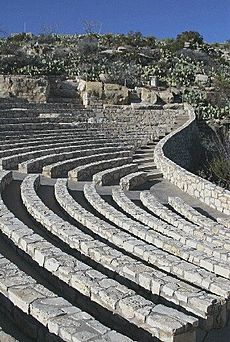
Besides the caves, the park has ten hiking trails. You can explore the desert scenery and see different plants and animals. The area around the cave entrance is a historic district.
There's also a special place called Rattlesnake Springs Picnic Area. It's a natural oasis in the desert with picnic tables and lots of wildlife. Over 300 types of birds have been seen here, making it a very important spot for birdwatching. The natural entrance to the caverns is also important for its huge colony of cave swallows.
Scientists have even found bacteria in the isolated Lechuguilla Cave that are resistant to antibiotics. This helps them learn about how antibiotic resistance developed over time.
The park also has several springs and tinajas (natural rock pools). You can hike to Oak Spring, which is near the visitor center.
See also
 In Spanish: Parque nacional de las Cavernas de Carlsbad para niños
In Spanish: Parque nacional de las Cavernas de Carlsbad para niños
- List of national parks of the United States
- Guadalupe Mountains National Park
- Big Bend National Park
- White Sands National Park
- Caverns of Sonora
- McKittrick Canyon
- Wind Cave National Park
- Mammoth Cave National Park
- U.S. Forest Service Blanchard Springs Caverns
- List of areas in the National Park System of the United States
- List of longest caves in the United States


